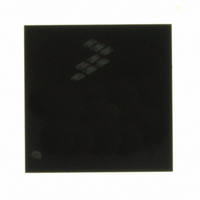MC9S08AC60CFDE Freescale Semiconductor, MC9S08AC60CFDE Datasheet - Page 56

MC9S08AC60CFDE
Manufacturer Part Number
MC9S08AC60CFDE
Description
IC MCU 8BIT 60K FLASH 48-QFN
Manufacturer
Freescale Semiconductor
Series
HCS08r
Datasheet
1.MC9S08AC60CFJE.pdf
(348 pages)
Specifications of MC9S08AC60CFDE
Core Processor
HCS08
Core Size
8-Bit
Speed
40MHz
Connectivity
I²C, SCI, SPI
Peripherals
LVD, POR, PWM, WDT
Number Of I /o
38
Program Memory Size
60KB (60K x 8)
Program Memory Type
FLASH
Ram Size
2K x 8
Voltage - Supply (vcc/vdd)
2.7 V ~ 5.5 V
Data Converters
A/D 8x10b
Oscillator Type
Internal
Operating Temperature
-40°C ~ 85°C
Package / Case
48-QFN
Processor Series
S08AC
Core
HCS08
Data Bus Width
8 bit
Data Ram Size
2 KB
Interface Type
I2C/SCI/SPI
Maximum Clock Frequency
40 MHz
Number Of Programmable I/os
56
Number Of Timers
3
Maximum Operating Temperature
+ 85 C
Mounting Style
SMD/SMT
3rd Party Development Tools
EWS08
Development Tools By Supplier
DEMO9S08AC60E, DEMOACEX, DEMOACKIT, DCF51AC256, DC9S08AC128, DC9S08AC16, DC9S08AC60, DEMO51AC256KIT
Minimum Operating Temperature
- 40 C
On-chip Adc
16-ch x 10-bit
Controller Family/series
HCS08
No. Of I/o's
38
Ram Memory Size
2KB
Cpu Speed
40MHz
No. Of Timers
3
Rohs Compliant
Yes
Height
1 mm
Length
7 mm
Supply Voltage (max)
5.5 V, 5.5 V
Supply Voltage (min)
2.7 V, 2.7 V
Width
7 mm
For Use With
DEMO9S08AC60E - BOARD DEMO FOR MC9S08A
Lead Free Status / RoHS Status
Lead free / RoHS Compliant
Eeprom Size
-
Lead Free Status / Rohs Status
Lead free / RoHS Compliant
- Current page: 56 of 348
- Download datasheet (4Mb)
Chapter 4 Memory
4.4.7
Whenever any block protection is enabled, the reset and interrupt vectors will be protected. Vector
redirection allows users to modify interrupt vector information without unprotecting bootloader and reset
vector space. Vector redirection is enabled by programming the FNORED bit in the NVOPT register
located at address $FFBF to zero. For redirection to occur, at least some portion but not all of the FLASH
memory must be block protected by programming the NVPROT register located at address $FFBD. All of
the interrupt vectors (memory locations $FFC0–$FFFD) are redirected, while the reset vector
($FFFE:FFFF) is not. When more than 32K is protected, vector redirection must not be enabled.
For example, if 512 bytes of FLASH are protected, the protected address region is from $FE00 through
$FFFF. The interrupt vectors ($FFC0–$FFFD) are redirected to the locations $FDC0–$FDFD. Now, if an
SPI interrupt is taken for instance, the values in the locations $FDE0:FDE1 are used for the vector instead
of the values in the locations $FFE0:FFE1. This allows the user to reprogram the unprotected portion of
the FLASH with new program code including new interrupt vector values while leaving the protected area,
which includes the default vector locations, unchanged.
4.5
The MC9S08AC60 Series includes circuitry to prevent unauthorized access to the contents of FLASH and
RAM memory. When security is engaged, FLASH and RAM are considered secure resources. Direct-page
registers, high-page registers, and the background debug controller are considered unsecured resources.
Programs executing within secure memory have normal access to any MCU memory locations and
resources. Attempts to access a secure memory location with a program executing from an unsecured
memory space or through the background debug interface are blocked (writes are ignored and reads return
all 0s).
Security is engaged or disengaged based on the state of two nonvolatile register bits (SEC01:SEC00) in
the FOPT register. During reset, the contents of the nonvolatile location NVOPT are copied from FLASH
into the working FOPT register in high-page register space. A user engages security by programming the
NVOPT location which can be done at the same time the FLASH memory is programmed. The 1:0 state
disengages security while the other three combinations engage security. Notice the erased state (1:1)
makes the MCU secure. During development, whenever the FLASH is erased, it is good practice to
immediately program the SEC00 bit to 0 in NVOPT so SEC01:SEC00 = 1:0. This would allow the MCU
to remain unsecured after a subsequent reset.
The on-chip debug module cannot be enabled while the MCU is secure. The separate background debug
controller can still be used for background memory access commands, but the MCU cannot enter active
background mode except by holding BKGD/MS low at the rising edge of reset.
A user can choose to allow or disallow a security unlocking mechanism through an 8-byte backdoor
security key. If the nonvolatile KEYEN bit in NVOPT/FOPT is 0, the backdoor key is disabled and there
is no way to disengage security without completely erasing all FLASH locations. If KEYEN is 1, a secure
user program can temporarily disengage security by:
56
1. Writing 1 to KEYACC in the FCNFG register. This makes the FLASH module interpret writes to
the backdoor comparison key locations (NVBACKKEY through NVBACKKEY+7) as values to
be compared against the key rather than as the first step in a FLASH program or erase command.
Security
Vector Redirection
MC9S08AC60 Series Data Sheet, Rev. 2
Freescale Semiconductor
Related parts for MC9S08AC60CFDE
Image
Part Number
Description
Manufacturer
Datasheet
Request
R
Part Number:
Description:
Manufacturer:
Freescale Semiconductor, Inc
Datasheet:
Part Number:
Description:
Manufacturer:
Freescale Semiconductor, Inc
Datasheet:
Part Number:
Description:
Manufacturer:
Freescale Semiconductor, Inc
Datasheet:
Part Number:
Description:
Manufacturer:
Freescale Semiconductor, Inc
Datasheet:
Part Number:
Description:
Manufacturer:
Freescale Semiconductor, Inc
Datasheet:
Part Number:
Description:
Manufacturer:
Freescale Semiconductor, Inc
Datasheet:
Part Number:
Description:
Manufacturer:
Freescale Semiconductor, Inc
Datasheet:
Part Number:
Description:
Manufacturer:
Freescale Semiconductor, Inc
Datasheet:
Part Number:
Description:
Manufacturer:
Freescale Semiconductor, Inc
Datasheet:
Part Number:
Description:
Manufacturer:
Freescale Semiconductor, Inc
Datasheet:
Part Number:
Description:
Manufacturer:
Freescale Semiconductor, Inc
Datasheet:
Part Number:
Description:
Manufacturer:
Freescale Semiconductor, Inc
Datasheet:
Part Number:
Description:
Manufacturer:
Freescale Semiconductor, Inc
Datasheet:
Part Number:
Description:
Manufacturer:
Freescale Semiconductor, Inc
Datasheet:
Part Number:
Description:
Manufacturer:
Freescale Semiconductor, Inc
Datasheet:










